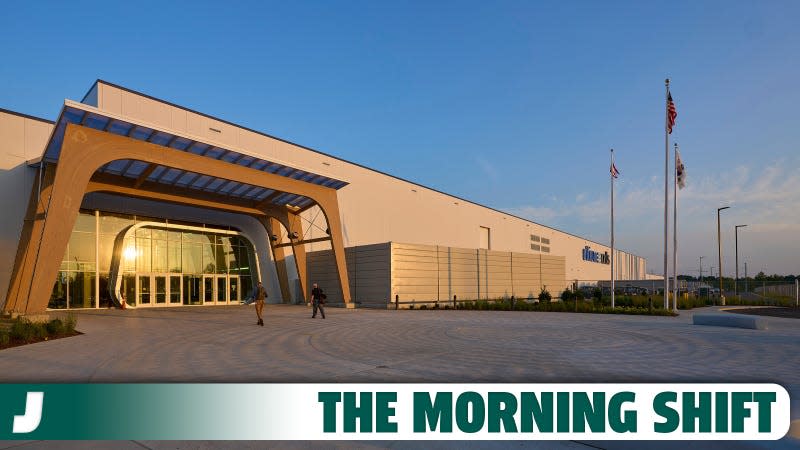Union Says GM, LG's Ultium Battery Plant Needs To Be Safer

Good morning! It’s Monday, July 10, 2023 and this is The Morning Shift, your daily roundup of the top automotive headlines from around the world, in one place. Here are the important stories you need to know.
1st Gear: Ultium Cells Union Wants A Safer Battery Plant
It’s entirely likely the United Auto Workers strikes against at least one of Detroit’s Big Three ahead of the union’s current contract expiring on September 14. UAW also recently organized General Motors and LG’s new Ultium Cells division, and as part of overall negotiations this summer, the union will be petitioning for improved safety protocols.
Read more
Twenty-two workers have been injured at the Ohio facility since it began operation last September, according to data supplied by the union to Bloomberg. That works out to 2.2 injuries per 100 workers, double the average for battery plants. Ultium Cells also paid out $68,000 to the Occupational Safety and Health Administration for non-injury claims over that time, twice what another battery supplier, SK, has been fined at its Georgia factory. Here’s some of what’s going on in Warren, courtesy Bloomberg:
Battery-cell plants are more like chemical factories than conventional auto-production facilities, where injuries are more likely to be from machinery accidents or repetitive tasks.
A year ago, a contractor at the Ultium plant was crushed by an automated crane while working inside the plant, suffering serious injuries, according to Travis Eastham, the local fire-station chief. The worker was hospitalized for months and later died of his injuries, Eastham said in a phone interview.
At the time, the company confirmed a subcontractor was injured at the plant, but declined to discuss the incident further.
In a white paper, the union said Ultium worker Gavin Currey was sprayed with toxic gas in early May while working in an area that extracts a poisonous electrolyte compound from battery cells. Currey said in the paper he experienced minor burns to his face and a union official said he was unable to work for three days.
Another worker, Mandy McCoy, told the union she saw a colleague put toxic waste in a garbage can, emitting fumes that made her and a coworker nauseous. McCoy said her colleague was taken to the hospital.
This in addition to another incident at the top of the story, in which a defective battery caught fire:
The workers raced to put it out, and were able to do so, according to the fire department near the facility in Lordstown, Ohio. While no one faced life-threatening injuries, two people were sent to the hospital for smoke inhalation — adding tension to an already strained relationship between the plant’s workers and its managers.
The UAW’s position is that automakers are benefitting from big subsidies for their new battery plants, thanks to Inflation Reduction Act incentives on every vehicle sold. Union members want to see that wealth shared and invested in safety procedures. As it stands, employees under joint ventures like the one GM has with LG at the Ultium facility don’t fall under the UAW’s existing contract with GM, so they’re not paid competitive wages.
When reached out for comment, an Ultium spokesperson reiterated to Bloomberg that “safety is a top priority each day,” and that the plant now has four union members as safety representatives. Back in May, Ultium Cells temporarily suspended four employees in the electrolyte mixing department for refusing to work until a safety shower was installed.
2nd Gear: GM Keeps Its Lead
Two years ago Toyota snapped GM’s streak of leading U.S. new car sales, but GM took the title right back in 2022. We’re only a little more than halfway through 2023, but GM appears poised to widen the gap to second place. From Automotive News:
Through June, GM outsold Toyota Motor North America by nearly 250,000 vehicles, far more than the roughly 42,000 that separated the two in mid-2022, according to the Automotive News Research & Data Center.
The supply constraints that helped Toyota unseat GM in 2021 and that have hindered production throughout the industry for two years are easing, boosting inventory to feed pent-up demand from both fleet and retail buyers, analysts said.
Signs point to continued improvement in the second half of the year. The seasonally adjusted, annualized rate of sales was 15.8 million vehicles in June, at the high end of forecasters’ estimates and the third-highest of the year, according to Motor Intelligence. That’s an improvement from 15.1 million in May and 13.1 million a year earlier, when shortages of semiconductors and other key parts had dealers starving for products.
As the supply chain has recovered, so has GM’s performance. That’s not to say Toyota wasn’t hit by the same constraints; it was just better prepared for them at the onset. Once its stockpile of chips ran out, it fell short just like everyone else.

 Yahoo Autos
Yahoo Autos 